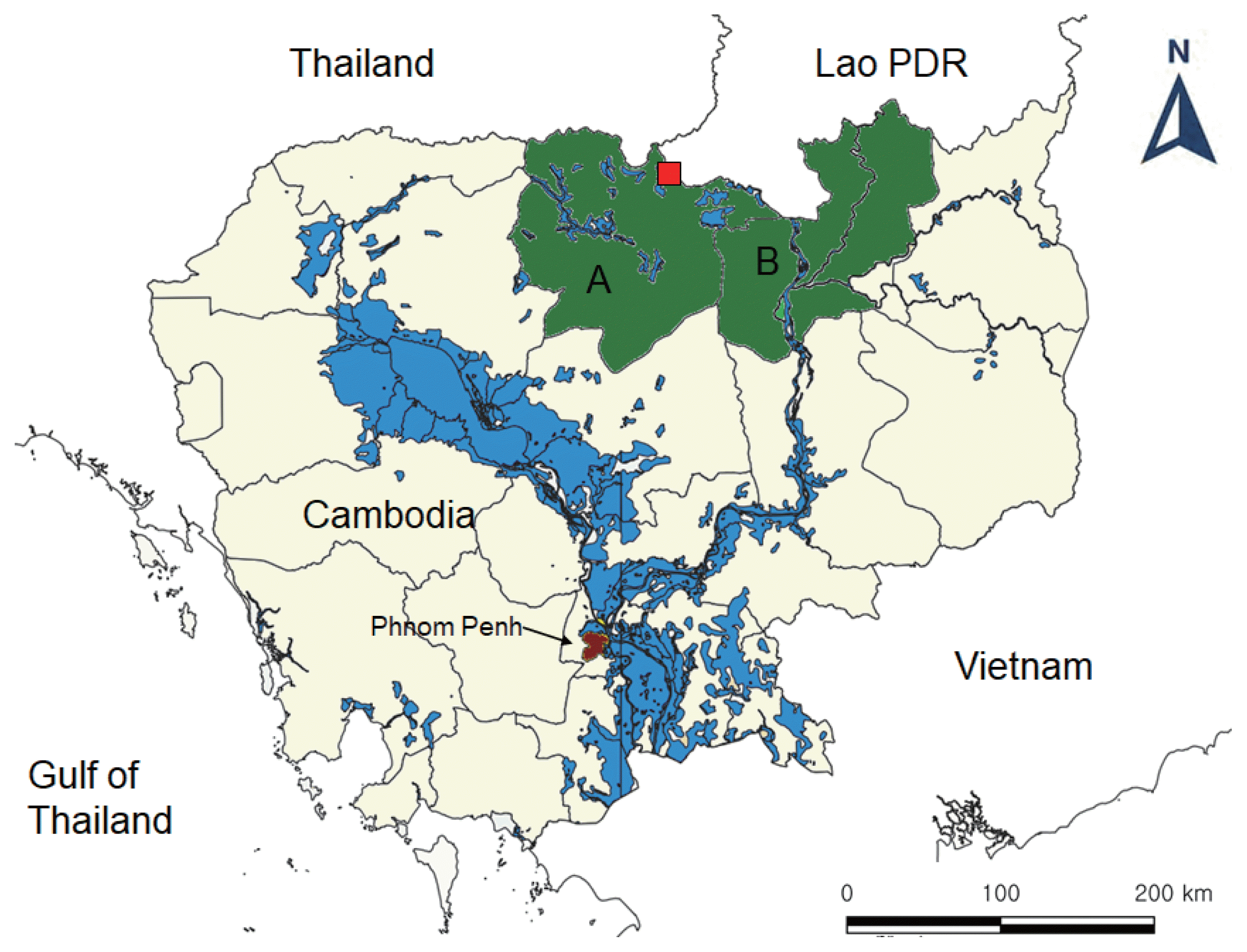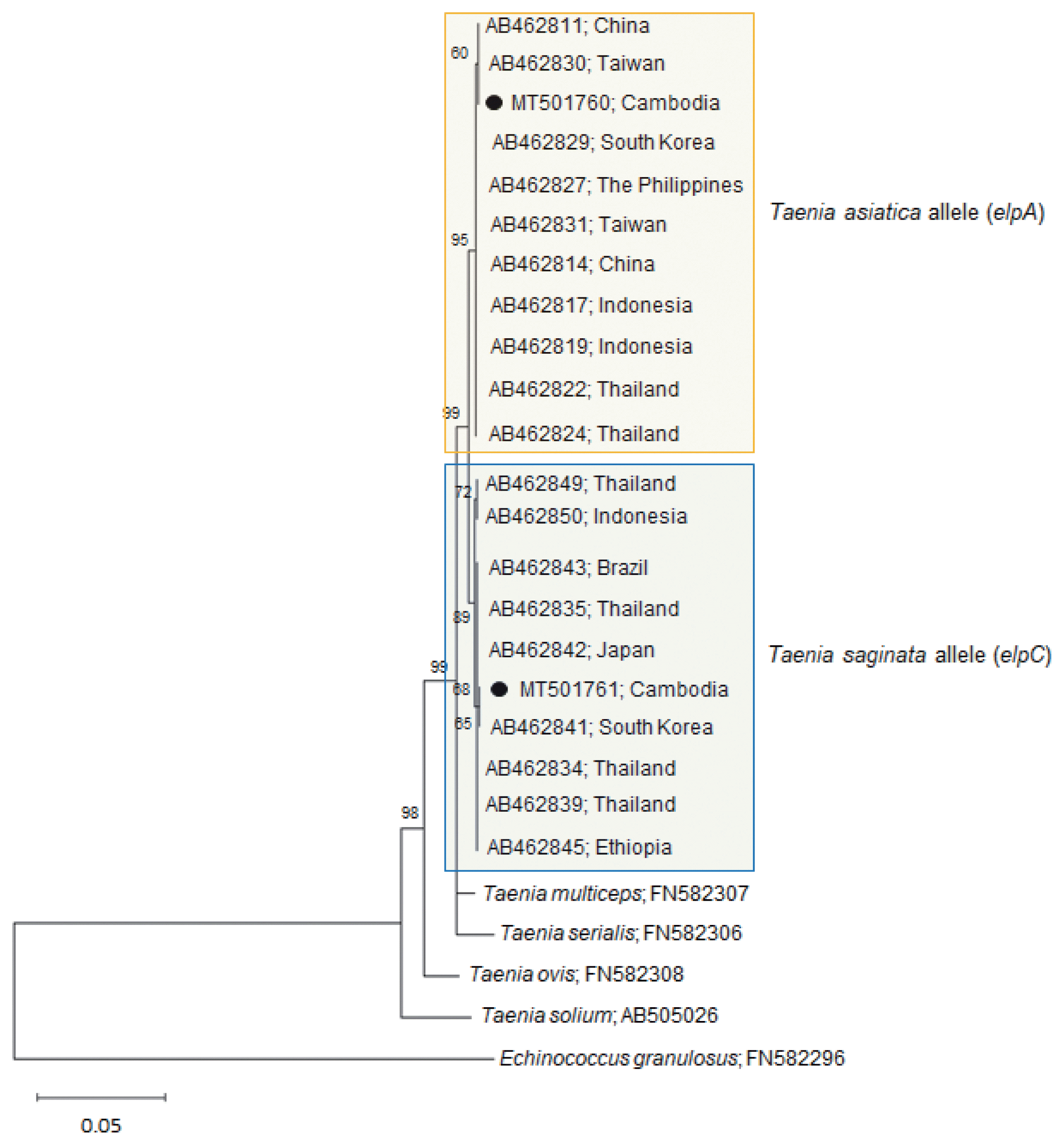Taenia solium,
Taenia saginata, and
Taenia asiatica are 3 tapeworm species that can cause human intestinal infections. They have unique life cycles, taking humans as the only definitive host and pigs or cattle as the intermediate host [
1].
T. asiatica, which is transmitted by swine (viscera), was first identified in Taiwan and then in South Korea and reported as a distinct species from
T. saginata in 1993 [
1,
2]. The distribution of human taeniases by
T. solium and
T. saginata is worldwide, whereas
T. asiatica is found mostly in Asian countries [
3,
4].
The possibility of hybridization between
T. asiatica and
T. saginata has been raised in previous studies that analyzed samples from several countries, including Thailand, China, the Philippines, and Lao PDR [
5–
8]. Although the 2 taxa have distinct biological characteristics, including host specificity, gene exchange between the 2 species was strongly suggested using allelic analysis on mitochondrial and nuclear genetic markers [
5]. The existence of
T. solium and
T. saginata in Cambodia was confirmed by DNA sequencing of egg-positive fecal samples and adult worms expelled from residents [
9,
10]. However, there has been no report on the occurrence of
T. asiatica or a hybrid between
T. saginata and
T. asiatica in humans despite its geographical location, surrounded by other countries where
T. asiatica and hybrids between the 2 species have been found [
5–
8,
11]. In this study, we report a hybrid individual between
T. saginata and
T. asiatica in a northern part of Cambodia, bordering Lao PDR, suggesting the occurrence of
T. asiatica in this country.
Fecal samples were collected from total 1,156 people in 2 northern provinces (5 villages each), Preah Vihear and Stung Treng (
Fig. 1), and examined by the Kato-Katz thick smear technique, as previously reported [
10]. The fecal survey of people and worm collection after praziquantel medication were ethically approved by National Ethics Committee for Health Research, Cambodia (IRB no. 099NECHR). Twenty-six (2.4%) out of them were positive for
Taenia spp. eggs, and 3 tapeworm strobilae were collected from 3 patients in Preah Vihear after praziquantel medication (15 mg/kg single dose) and purging with MgSO
4.
Two of the 3 strobilae were diagnosed molecularly as ‘pure’
T. saginata based on the mitochondrial gene encoding cytochrome c oxidase subunit 1 (
cox1), and 2 nuclear genes encoding elongation factor-1α (
ef1) and ezrin-radixin-moesin (ERM)-like protein (
elp) which were reported previously [
10]. The remaining 1 strobila (75 cm in length, mostly gravid proglottids without a scolex) expelled from a 27-year-old man showed strange results that the
elp allele type was different from ‘pure’
T. saginata. In this study, we further analyzed the allele type of the
elp gene of this strobila. The sample preparation and genomic DNA extraction were conducted as described in our previous study [
10]. The analyses of mitochondrial
cox1 (1,620 bp) and 2 nuclear genes
ef1 (1,090 bp) and
elp (1,160 bp) were performed following conditions of Okamoto et al. [
5]. A consistent sequence data of
elp locus could not be obtained since double peaks were observed in electropherograms. Thus, to confirm the haploid genotype of
elp locus, PCR amplification and sequencing were conducted at the single-allele level using T-Blunt PCR cloning kit (Solgent, Seoul, Korea).
Multiple sequences alignment was constructed with Clustal W [
12]. A phylogenetic tree of
elp locus sequences identified in this study and representative sequences of
Taenia spp. available in the GenBank database were constructed using the maximum-likelihood (ML) method based on the Tamura-Nei model of nucleotide substitution. The tree was viewed by MEGA v6 [
13]. Bootstrap values were calculated with 1,000 replications.
Our
Taenia strobila sample showed a discrepancy in the diagnosis between the mitochondrial and nuclear genes. It possessed homozygous sequences typical of
T. saginata cox1 (MT074050) and
ef1 (MT075318) loci. However, at the
elp locus, it was heterozygous with 1 allele (MT501760) matched with
T. asiatica (
elpA) and another (MT501761) with
T. saginata (
elpC) (
Table 1;
Fig. 2).
The homology between our allele sample elpA and T. asiatica (AB462829-AB462830) was 99.9–100%, whereas the homology between our sample elpA and T. saginata (AB462841-AB462842) or T. solium (AB505026) was lower than that, 99.1–99.2% or 94.7%, respectively. In addition, the homology between our allele sample elpC and T. saginata (AB462841-AB462842) was 99.9–100%, whereas the homology between our sample elpC and T. asiatica (AB462829-AB462830) or T. solium (AB505026) was lower than that, 99.1–99.2% or 94.8%, respectively. These results strongly suggest that our sample is a hybrid between the 2 Taenia species.
Hybridization between
T. saginata and
T. asiatica was reported recently in Asian countries [
5–
8] but not yet in Cambodia. In this study, we performed an allelic analysis of a
Taenia tapeworm strobila collected from a human to rule out the hybrid issue in Cambodia and confirmed that our specimen is a hybrid between
T. saginata and
T. asiatica.
Human taeniases (by
T. solium,
T. asiatica, and
T. saginata) are known to be endemic in East and Southeast Asia, including Thailand, Vietnam, Lao PDR, which neighbor with Cambodia, and also in Nepal and India [
8,
11,
14]. However, in Cambodia, reports of human taeniasis due to
T. asiatica have not yet been documented. Our present finding implies the possible existence of
T. asiatica in the northern part of Cambodia, although it remains to be confirmed by further studies.
The transmission of tapeworms is closely related to the lifestyle and cultural characteristics of people, which involve the consumption of undercooked meat infected with viable metacestodes (i.e., cysticerci) [
14]. In Cambodia, there is a traditional food habit of eating cattle or pig meat, for example raw beef salad (‘
pleah sach ko’). However, as the intermediate host and life cycle of the hybrid between
T. saginata and
T. asiatica are unclear now, it is necessary to examine the metacestodes from domestic animals using genetic markers. Thus, the risk factors as well as the level of exposure of the people in Cambodia to the agents causing human taeniases, including the hybrid, should be evaluated.



